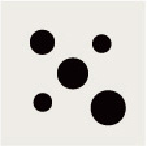Graphics Reference
In-Depth Information
the design isn't challenging enough, the viewer's attention might shift elsewhere before
he or she has acquired the content of the message. A lack of visual, and thus cognitive,
investigation is also likely to not make much of an impression on the viewer and, unfor-
tunately, become difficult to recall later on. Asymmetrical arrangements provoke more
rigorous involvement—they require the brain to assess differences in space and stimu-
late the eye to greater movement. From the standpoint of communication, asymmetrical
arrangements might improve the ability to differentiate, catalog, and recall content be-
cause the viewer's investigation of spatial difference becomes tied to the ordering, or
cognition, of the content itself.
Symmetrical spatial intervals are inherently static, and their static quality is greater the smaller (or
fewer in number) the elements that separate them.
Form elements and spatial intervals that share a similar presence in volume or weight produce the
most static configuration possible.
As the relative size or number of elements within a symmetrical arrangement increases, the static
quality decreases but remains present.




